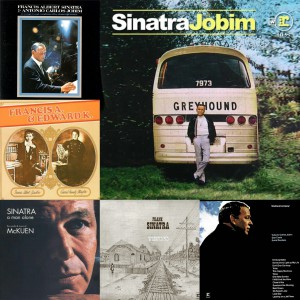With the forming of his own Reprise Records at the dawn of the 1960s, Frank Sinatra was free to pursue a life of artistic independence. Working with the likes of arrangers Johnny Mandel, Sy Oliver, Neal Hefti, as well as regular collaborators Nelson Riddle, Gordon Jenkins, and Billy May, Sinatra made the type of albums he wanted to make without the influence of an employer.
Under the veteran eye of chief producer Sonny Burke, Sinatra made nearly a dozen albums for his label between the years 1960 and 1967, venturing into styles and fortes of music as he never had before.
As the years endured, the average fan could see Sinatra venturing out of his comfort zone (straight standards) more frequently, carefully embracing the sound of more modern genres and attaching them to the melody of his arrangements while remaining faithful to the formula of his contingent. He found comfort and potential in the burgeoning style of soft rock, beginning with the 1964 recording of “Softly, As I Leave You,” following with several similarly styled singles as well as the 1968 album “Cycles” arranged by Don Costa. In terms of the other albums he had released during the era, it was a completely different story.
Although he had previously joined forces with other personalities (arranger Nelson Riddle on several consecutive albums at Capitol Records in the 1950s, as well as with the Count Basie Orchestra on two albums in the early 1960s), the last five years of his recorded output before his first retirement in 1971 included perhaps the most intricate collaboration and artistic endeavor he had attempted throughout his entire career.
Driving himself to new heights as a well-rounded recording artist amongst a few contemporary albums and singles, Sinatra would lay down some of his most unique music, all with the addition of notable guest artists.
Antonio Carlos Jobim (1967/1969)
Released in March 1967, the album Francis Albert Sinatra And Antonio Carlos Jobim features Sinatra embracing a singular musical medium; in this case, the Brazilian born rhythms of bossa nova, and to his left playing guitar in studio, the man considered the father of this distinctive sound, singer-songwriter Antonio Carlos Jobim. Featuring a number of Jobim’s own compositions as well as a few standards tailored into the rhythmic bossa nova style, it’s some of the softest – and most tender – Sinatra singing you will ever hear, arranged and conducted by verteran Claus Ogerman. Heading off with the trademark “Girl From Ipanema,” Sinatra mellows his way through a tender set of melodies that includes “Quiet Nights of Quiet Stars,” “Meditation,” and the sexy recast of a former swing song “Baubles, Bangles and Beads,” often with Jobim himself lending occasional vocal support.
Hoping to recapture the same magic that their first album sparked, Sinatra and Jobim met again in studio in 1969 to recorded another ten selections under the banner of Sinatra/Jobim, with orchestra this time under direction of Eumir Deodato. Featuring even more rhythmic arrangements, the second collaboration is even more thrilling then the first, highlights including “The Song of the Sabia,” the driving bachata of “Agua de Beber,” the lowest notes ever hit by Frank on Jobim’s illustrious “Wave,” as well as a true duet between Frank and Antonio with the delightful “Desafinado.”
Unhappy with the final product as well as the resulting album cover, Sinatra pulled the plug on the second Jobim project very shortly after a series of 8-track copies were produced (copies of this production are today considered ultra-rare and valuable).
Seven of the selections from these sessions would eventually appear on the front side of a hastily-produced 1970 LP known as Sinatra and Company, with the flip side of the record consisting of contemporary tunes (two written by John Denver) arranged by Don Costa. In 2010, Concord Records collected all twenty tunes from both the 1967 and 1969 Jobim recording dates and released them in one compiled package Sinatra-Jobim: The Complete Reprise Recordings, marking the first time (besides the Complete Reprise box set) that the three tunes (Sabia/Desafinado/Bonita) deleted from release in 1969 could be heard.
*** Interestingly enough, the final sessions for the first Jobim album were held on the same evening that the first sessions for Sinatra’s duet with daughter Nancy, “Somethin’ Stupid,” took place in the same studio. It would later go on to win Sinatra’s second gold record in addition to spending four weeks at number one on the Billboard charts. ***
Duke Ellington (1968)
Recorded in December of 1967, Francis A. and Edward K. stands a recorded testament that the most eloquent of albums can result from such inconvenient circumstances. Having been a member of Sinatra’s Reprise family for several years, plans were finally put in place for Duke Ellington and his orchestra to record an album with Sinatra. Consisting of eight (long) tracks, all accounts for the sessions of this release border on disastrous. Unprepared orchestra members coupled with Sinatra suffering from a cold on the eve of his 52nd birthday resulted in an air of high tension in studio. However, an album of glorious performances resulted, from both Frank and the band.
Billy May arranges and conducts the Ellington ensemble through the program of varying tempo, which includes swinging statements of “Follow Me,” from the Broadway production of “Camelot,” as well as “All I Need Is The Girl” from “Gypsy,” not to mention the moaningly brilliant “Indian Summer” as well as the full-throttle closing of Lane and Lerner’s “Come Back To Me.” This is album is second only to the Jobim works in this late 60s period.
Rod McKuen (1969)
Albums of poetry set to music became a fad of sorts as the 1960s wore on, perhaps made famous (or infamous) by William Shatner’s regarded 1968 LP release of “The Transformed Man,” in which television’s Captain Kirk spews Shakespeare and other spoken works to melodies of popular songs. Sinatra, perhaps looking to completely reinvent himself, had recently been introduced to poet Rod McKuen, and with his published works enjoying enormous popularity at the time with the American public, asked McKuen to create a full album of music for him.
The result was A Man Alone. Arranged and conducted by Don Costa, the full program (centered on loneliness and wistful memories of lost romance) seemed fit for a character like Sinatra, whose earlier albums of torch songs (Wee Small Hours, Only The Lonely) could be considered a blueprint for this type of work. Consisting of both songs as well as word verses spoken atop orchestral background, Sinatra tells tales of a single man alone in the night with memories of how love had been good to him in the past. Complimented by Costa’s lush writing for strings, it’s an interesting affair.
The “Four Seasons” influence (1969)
Lambasted by critics at the time and neglected by record buyers, the album Watertown finds Sinatra at the close of the 1960s at his most daring. Desperately trying to keep with the times in the face of declining sales, Sinatra turned to the team of Bob Gaudio (best known as an original member of The Four Seasons) and Jake Holmes, who presented Sinatra with a full musical program. Sinatra had invented the “concept album” (albums centered around a feeling or theme) at Columbia in the 1940s and had used it to its potential throughout his Capitol years in the 1950s.
Watertown would be the first time in several years that he had recorded an album as such, the eleven songs together telling the story of a woman leaving her husband and two sons in the small town in which they reside for her dreams in the big city, the narrative dealing with his conflicted emotions to her desertion and his resilience to continue raising his children.
From the opening riff, one can tell this isn’t the usual Sinatra, but it is good Sinatra. The pounding bass line behind Frank in the opening tune sounds a bit unusual at first to the avid Sinatra fan, but the ambition is prevalent.
With the sound of a locomotive recreated in studio playing over the final notes of the first tune, one could say that the story Sinatra’s singing portrays in this album is easily pictured with the close of eyes.
If for nothing else, the beautiful love song “Elizabeth” is a standout performance on this album and holds up well on its own.
Ambitious as it was, it was first Sinatra album not to break the top 100 on the Billboard charts.
While the majority of these albums are today held in high regard by both Sinatra fans and musical connoisseurs alike, record sales at the time would prove less than favorable throughout the latter half of the period, another factor that resulted in Sinatra’s withdrawal from the music business in 1971. As time would soon tell though, his “retirement” would be anything but long.
Until next time, Sinatra lovers!
Jerry Pearce is an amateur singer in the vein of Frank Sinatra, Perry Como, and Dick Haymes and has released two discs of standards music, Crossroads in 2010, and One Summer Night in 2016. Samples of his music can be heard on his YouTube Channel. To purchase his CDs use the form box below.
[si-contact-form form=’3′]

 May 9th, 2016
May 9th, 2016  CEO
CEO 
 Posted in
Posted in  Tags:
Tags: 



